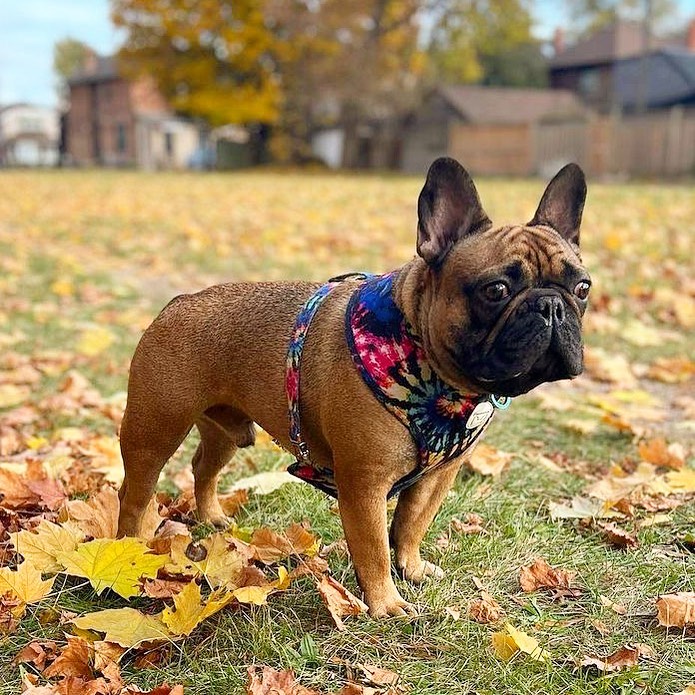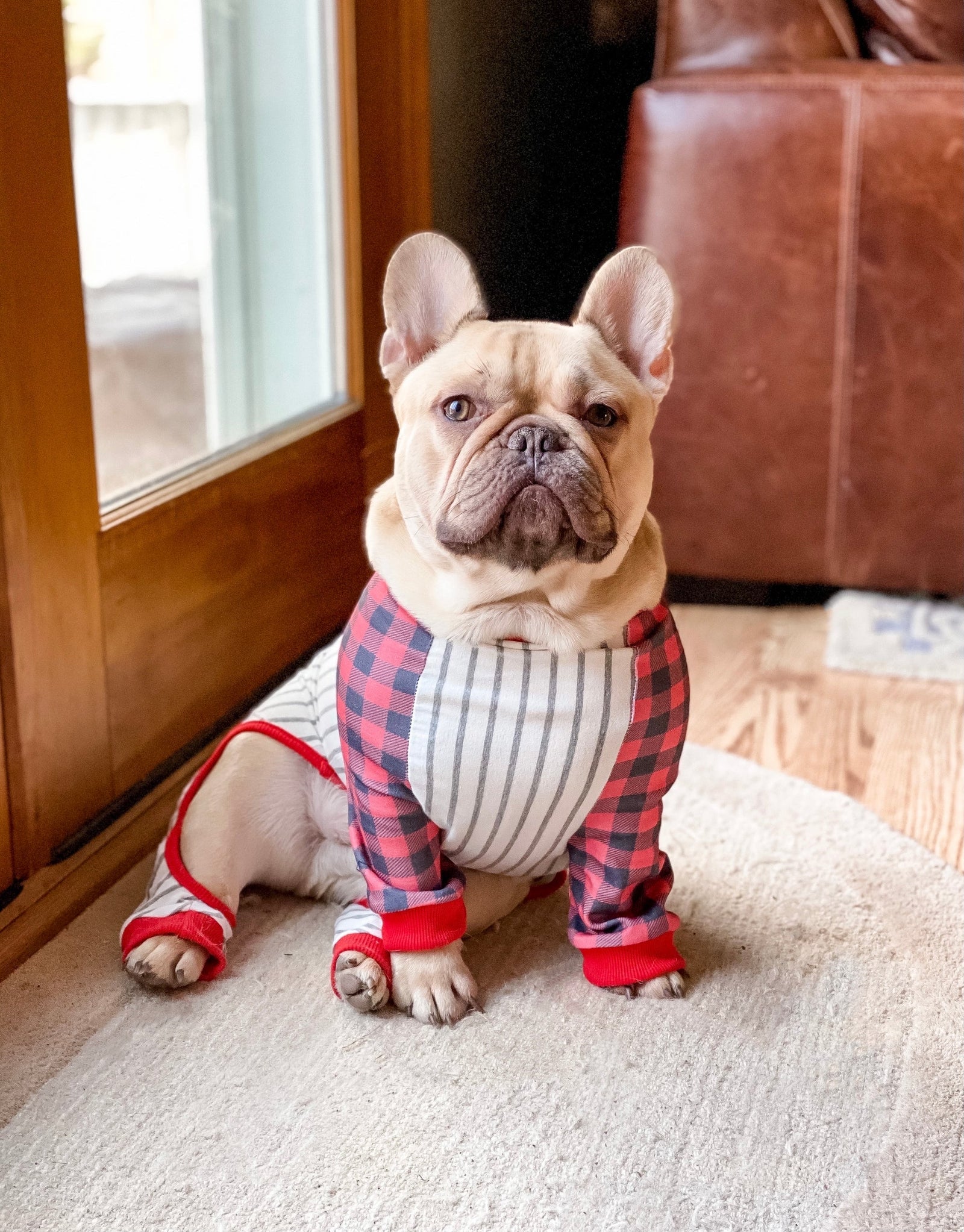Your Cart is Empty
🔥 CLOSE OUT SALE 🔥50% OFF sitewide use code clear final sale, no returns or refunds
🔥 CLOSE OUT SALE 🔥50% OFF sitewide use code clear final sale, no returns or refunds
🔥 CLOSE OUT SALE 🔥50% OFF sitewide use code clear final sale, no returns or refunds

French Bulldogs are cherished members of many families. Just like any other family member, it's essential to be prepared for unforeseen situations that may require immediate attention. Here's a comprehensive guide on how to give your Frenchie first aid, ensuring their well-being in times of need.
Stay Calm: In moments of stress or panic, it's natural to feel overwhelmed. However, maintaining a calm demeanor is essential. Take a deep breath to center yourself; this will not only help you think more clearly but also prevent your Frenchie from picking up on your anxiety.
Secure the Area: Ensuring the safety of both you and your Frenchie is the first step. Move away from any potential dangers, such as busy roads, sharp objects, or other hazards. If your Frenchie is injured or distressed, gently move them to a safe and quiet space where you can better assess the situation.
Check for Responsiveness: Determine if your Frenchie is conscious and responsive. Gently tap them and speak in a calm and reassuring tone. Check for any signs of movement, responsiveness, or unusual behavior. If your Frenchie is unconscious or non-responsive, this indicates a serious situation that requires immediate attention.
Observe Breathing and Pulse: Assess your Frenchie's breathing and pulse. Place your hand on their chest to feel for breathing, and check for a pulse by feeling the femoral artery (located inside the hind leg). Abnormalities in breathing or the absence of a pulse may indicate a critical condition, such as choking, cardiac issues, or respiratory distress.
Evaluate for Obvious Injuries: Examine your Frenchie for any visible injuries. Look for signs of bleeding, bruising, or wounds. Pay attention to their limbs, head, and body. Identifying and addressing visible injuries promptly is crucial for providing effective first aid.

Signs: Difficulty breathing, pawing at the mouth, coughing or wheezing.
Assess the Severity: If your Frenchie is still able to breathe, cough, or make noise, encourage them to continue coughing to try and clear the obstruction.
Perform the Heimlich Maneuver: If your Frenchie is struggling to breathe and the obstruction hasn't cleared, perform the Heimlich maneuver for dogs:
Clear the Mouth: If you can see the object causing the obstruction and it's easily reachable, carefully remove it with pliers or tweezers.
Monitor Breathing: After the obstruction is dislodged, monitor your Frenchie's breathing. Seek veterinary attention even if they seem fine, as there could be internal injuries.
Supervise Mealtime: Supervise your Frenchie during mealtime, especially when they're prone to eating quickly.
Choose Appropriate Toys: Provide toys that are appropriately sized and cannot be easily chewed into small pieces.
Avoid Small Objects: Keep small objects, such as toys with small parts or household items, out of your Frenchie's reach.
Pet-Proof Your Home: Regularly check your living space for potential hazards and remove any items that could pose a choking risk.
Signs: Visible wounds, blood on fur or surroundings.
Assess the Severity: Determine the severity of the bleeding. Minor wounds may require less immediate attention, while severe bleeding demands prompt action.
Apply Direct Pressure: Use a clean cloth, sterile bandage, or gauze to apply direct pressure to the wound. This helps control bleeding and promotes clotting.
Elevate if Possible: If the wound is on a limb, elevate it to reduce blood flow to the area. Be cautious not to cause additional harm.
Clean the Wound: Once bleeding is controlled, clean the wound gently with mild soap and water.
Apply Antiseptic: Use pet-safe antiseptic to prevent infection. Avoid substances like hydrogen peroxide, as they can damage tissue.
Protect the Wound: Consider using a pet-friendly bandage or protective covering to keep the wound clean.
Severe Bleeding:If your Frenchie is experiencing severe bleeding that cannot be controlled by direct pressure and elevation.
Life-Threatening Situation: When the bleeding is life-threatening, and immediate measures are necessary to prevent excessive blood loss.
Use a wide and flat material, such as a belt, bandage, or a purpose-made tourniquet strap.
Locate the Bleeding Site: Identify the source of bleeding and ensure the tourniquet is applied proximal (closer to the body) to the bleeding site.
Place the Tourniquet: Wrap the tourniquet material around the limb, ensuring it is snug but not excessively tight. Do not place the tourniquet directly over a joint.
Secure with a Knot or Applicator: If using a belt or bandage, secure it with a knot. If an applicator is available, follow the manufacturer's instructions for proper application.
Note the Time: Remember the time the tourniquet was applied. This information is crucial for medical professionals.
Seek Veterinary Care Immediately: Applying a tourniquet is a temporary measure. Seek professional veterinary care as soon as possible.
Tightness Control: Avoid overtightening the tourniquet, as this can cause additional harm, including nerve and tissue damage.
Regularly Monitor: Continuously monitor your Frenchie's condition and adjust the tourniquet if needed. Loosen it slightly if there are signs of circulation compromise (Approximately every 15 minutes for 15 seconds).
Use as a Last Resort: Applying a tourniquet should be a last resort when all other attempts to control bleeding have failed.
Signs:Red or blistered skin, signs of pain.
Cool Water Rinse: Run cool (not cold) water over the burn for at least 10 minutes. This helps reduce the temperature of the skin and soothes the affected area.
Avoid Ice or Cold Packs: Never use ice or very cold packs directly on a burn, as extreme cold can worsen tissue damage.
Seek Veterinary Care: Even if the burn appears minor, consult with your veterinarian for further guidance. Burns can worsen over time, and professional evaluation is essential.
Pain Management: Your veterinarian may recommend pain medication to keep your Frenchie comfortable during the healing process.
Avoiding Irritants: Prevent your Frenchie from licking or scratching the burn, as this can worsen the injury.
Avoid Home Remedies: Refrain from using home remedies without consulting your veterinarian. Some substances may exacerbate the burn.
Signs: Excessive panting, drooling, lethargy, collapse.
Move to a Cooler Area: Immediately move your Frenchie to a cooler environment away from direct sunlight.
Cool Towels: Apply cool, wet towels to your Frenchie's body, focusing on the head, neck, and groin area.
Offer Sips of Water: Allow your Frenchie to drink small amounts of cool (not cold) water.
Avoid Cold Packs: Do not use ice or very cold packs, as extreme cold can constrict blood vessels and hinder the body's cooling process.
Seek Veterinary Care: Heatstroke is a medical emergency. Even if your Frenchie appears to recover, seek immediate veterinary attention for a thorough examination.
Avoid High Temperatures: Limit outdoor activities during peak temperatures, especially in hot weather.
Provide Shade: Always ensure your Frenchie has access to shaded areas when outdoors.
Hydration: Keep your Frenchie well-hydrated. Always have fresh water available.
Avoid Excessive Exercise: Moderate exercise is essential. Avoid strenuous activities, especially in warm weather.
Normal Breathing: Breathing should gradually return to a normal pace.
Alertness: Your Frenchie should become more alert and responsive.
Hydration: Signs of dehydration, like dry gums, should improve with rehydration.
Internal Damage: Heatstroke can cause internal damage even if external signs improve.
Brachycephalic Breeds: Brachycephalicbreeds, like French Bulldogs, are more susceptible to heat-related issues. Exercise caution in hot weather.
Preventive Measures: Focus on preventive measures to avoid heatstroke. Being proactive is key to your Frenchie's well-being.
Signs: Uncontrolled shaking, loss of consciousness.
Create a Safe Space: Clear the area around your Frenchie to prevent injury. Move away any objects that could pose a risk.
Avoid Physical Contact: Refrain from touching or restraining your Frenchie during the seizure. Dogs in a seizure state may unintentionally bite out of confusion.
Note the Duration: Seizures typically last for a few minutes. If a seizure continues for an extended period, seek immediate veterinary attention.
After the Seizure: Once the seizure ends, keep your Frenchie in a quiet and dimly lit space to help them recover.
Seek Veterinary Care: Consult with your veterinarian after the seizure. Seizures can have various underlying causes that require professional evaluation.
Epilepsy: A chronic neurological condition characterized by recurrent seizures. It may have a genetic component.
Underlying Health Issues: Seizures can be a symptom of various health issues such as liver disease, kidney failure, or toxins.
Trauma or Injury: Head injuries or trauma can trigger seizures.
Medication Management: If your Frenchie has a history of seizures, follow your veterinarian's prescribed medication regimen.
Regular Veterinary Check-ups: Schedule regular check-ups to monitor your Frenchie's overall health and address any potential triggers.
Environmental Safety: Create a safe environment, removing potential hazards that could lead to injury during a seizure.
Know Your Vet's Contact Information: Have your vet's number saved in your phone and know the location of the nearest emergency veterinary clinic.
Create a Pet First Aid Kit: Include essentials like bandages, gauze, adhesive tape and any medications your Frenchie may need.
Learn CPR for Dogs: Knowing how to perform cardiopulmonary resuscitation (CPR) for dogs can be lifesaving. Enroll in a pet first aid class to learn these skills.

In emergencies, every second counts. By being prepared and having the knowledge to administer basic first aid, you can provide crucial assistance to your Frenchie until professional veterinary care is available. Remember, always consult with your vet for guidance on your Frenchie's specific health needs.
Comments will be approved before showing up.

French Bulldogs, with their bat-like ears and affectionate personalities, have soared in popularity. However, their demand has fueled a surge in unethical breeding practices and scams, leaving many hopeful owners heartbroken or financially drained. This guide equips you with actionable steps to find ethical breeders, recognize red flags, and explore adoption alternatives—ensuring your Frenchie journey is safe, responsible, and rewarding.

For millions of pet owners, leaving a furry family member behind during travel is unthinkable. Whether for emotional support, medical necessity, or sheer companionship, the demand for pet-inclusive air travel has surged. By 2025, over 30 global airlines now permit cats and dogs in the cabin—a dramatic shift from just a decade ago, when pets were routinely relegated to cargo holds. This guide explores the evolving landscape of pet-friendly air travel, diving into airline policies, legal distinctions, health considerations, and tips for ensuring a smooth journey for all passengers, both human and animal.

Crate training is often associated with puppies, but it can be equally beneficial for older French Bulldogs. Whether your Frenchie is new to your home or simply hasn’t been crate trained before, introducing them to a crate can provide them with a safe and comforting space. Here’s how to do it effectively while keeping their unique personality and needs in mind.
Helpful information on the French Bulldog dog breed.
We will also notify you with new releases and special offers.
Informational posts about French Bulldogs. Tips and helpful advice on the Frenchie breed and other breeds.
Sign up to get information & expert advice about pets' health and safety. We will also notify you with new releases and special offers.